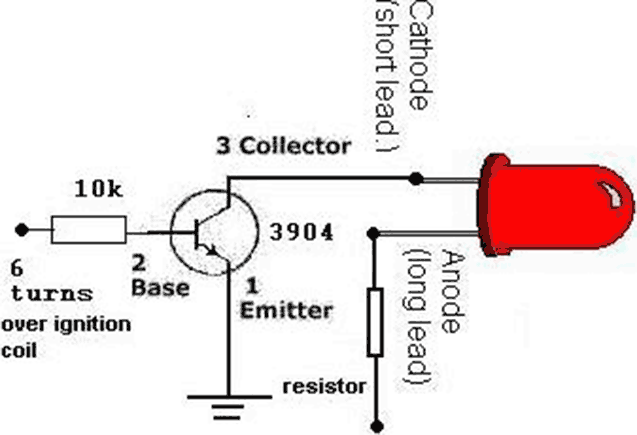
Bike LED Tachometer

Its based on inductive pickup and very easy to install. Have a look at the pic. (remove LED and connect transistor collector to pin4). I hope it will exactly suits to your tachometer. More: I found your PIC project collection very nice. I have been working on tachometer for my motorcycle. In your article you said that you don't know how to connect the signal wire to automotive.
The described circuit utilizes an inductive pickup method to detect the rotational speed of a motorcycle's engine, which is a common approach for tachometers. The inductive pickup sensor operates by generating a voltage signal in response to the changing magnetic field produced by the engine's ignition system or a rotating component. This signal can then be processed to provide an accurate reading of the engine RPM.
The installation process is straightforward, making it accessible for users with basic electronics knowledge. It is suggested to refer to a visual representation of the circuit, as indicated by the mention of a picture. The reference to removing an LED and connecting the transistor collector to pin 4 of a microcontroller implies that the circuit is designed to interface with a PIC microcontroller. This microcontroller will likely be responsible for processing the signal from the inductive pickup to calculate the RPM and display it on a connected output device.
The connection of the transistor collector to pin 4 indicates that this pin may serve as a digital input for the microcontroller, where the signal from the inductive pickup is read. This configuration allows the microcontroller to detect the voltage changes corresponding to the engine's rotational speed. Additional components, such as resistors and capacitors, may be necessary to condition the signal for optimal performance and to protect the microcontroller from voltage spikes.
It is important to ensure that the signal wire is correctly connected to the automotive system. This typically involves identifying the appropriate ignition coil or other relevant components where the inductive pickup can be installed to accurately sense the engine's activity. Proper installation and calibration are crucial for achieving reliable readings on the tachometer, which can enhance the motorcycle's performance monitoring and provide valuable feedback to the rider.Its based on inductive pickup and very easy to install. Have a look at the pic. (remove LED and connect transistor collector to pin4). I hope it will exactly suits to your tachometer. I found your PIC project collection very nice. I have been working on tachometer for my motorcycle. In your article you said that you don't know how to connect the signal wire to automotive. 🔗 External reference
The described circuit utilizes an inductive pickup method to detect the rotational speed of a motorcycle's engine, which is a common approach for tachometers. The inductive pickup sensor operates by generating a voltage signal in response to the changing magnetic field produced by the engine's ignition system or a rotating component. This signal can then be processed to provide an accurate reading of the engine RPM.
The installation process is straightforward, making it accessible for users with basic electronics knowledge. It is suggested to refer to a visual representation of the circuit, as indicated by the mention of a picture. The reference to removing an LED and connecting the transistor collector to pin 4 of a microcontroller implies that the circuit is designed to interface with a PIC microcontroller. This microcontroller will likely be responsible for processing the signal from the inductive pickup to calculate the RPM and display it on a connected output device.
The connection of the transistor collector to pin 4 indicates that this pin may serve as a digital input for the microcontroller, where the signal from the inductive pickup is read. This configuration allows the microcontroller to detect the voltage changes corresponding to the engine's rotational speed. Additional components, such as resistors and capacitors, may be necessary to condition the signal for optimal performance and to protect the microcontroller from voltage spikes.
It is important to ensure that the signal wire is correctly connected to the automotive system. This typically involves identifying the appropriate ignition coil or other relevant components where the inductive pickup can be installed to accurately sense the engine's activity. Proper installation and calibration are crucial for achieving reliable readings on the tachometer, which can enhance the motorcycle's performance monitoring and provide valuable feedback to the rider.Its based on inductive pickup and very easy to install. Have a look at the pic. (remove LED and connect transistor collector to pin4). I hope it will exactly suits to your tachometer. I found your PIC project collection very nice. I have been working on tachometer for my motorcycle. In your article you said that you don't know how to connect the signal wire to automotive. 🔗 External reference





